Nuphil Nu47, 1971 NZ Lord Rutherford FDC with James Berry Autograph, only 87 made
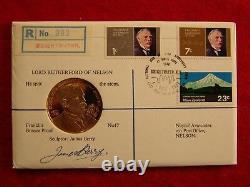
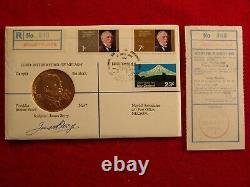
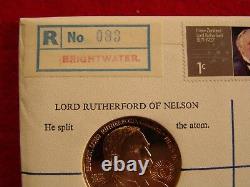
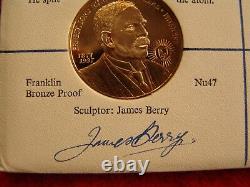
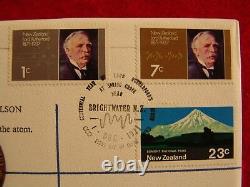
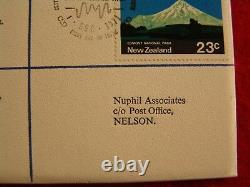
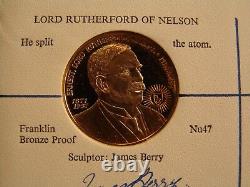
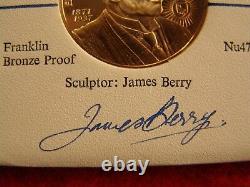
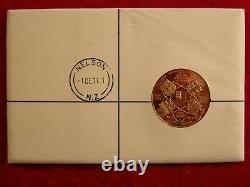
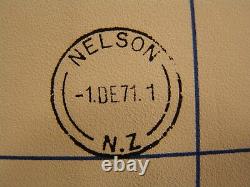
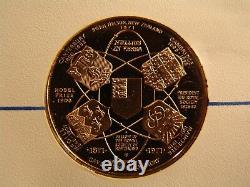
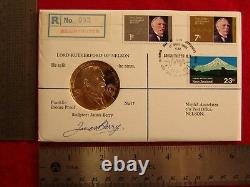

This is a listing for a PNC by Nuphil Associates Ltd. This is a two (2) piece set consisting of: one (1) PNC Cover containing a Franklin Mint Bronze Proof Coin honoring Lord Rutherford; and one (1) Registered Receipt No.
Number 83 of ONLY 87 produced. Franklin Mint Medal was designed by the famous New Zealand artist and sculptor, James Berry OBE (Order of the British Empire). This Registered Cover is also.
This PNC is a Registered First Day Cover with the 7c and 1c Lord Rutherford commemorative stamps on their first day of issue at Brightwater, the post office nearest to his (Rutherford) birthplace. The scientist took the title of Baron Rutherford of Nelson when he was elevated to the British peerage. Nuphil produced only 87 of these PNCs.
Number 83 and the Registered Number is 083, which is the serial number. The Nuphil NU47 PNCover displays the Lord Rutherford Full-Proof bronze medal of the Royal Society of New Zealand by James Berry at the Franklin Mint.
The obverse has an effigy of the pioneer of nuclear physics and the reverse is an attractive design embodying the Coat Of Arms of the scientist with those of the Universities where he did his vital research. Ernest Rutherford, 1st Baron Rutherford of Nelson. (30 August 187119 October 1937) was a British-New Zealand. Who became known as the father of. In early work he discovered the concept of radioactive half life, proved that radioactivity involved the transmutation of one chemical element to another, and also differentiated and named alpha and beta radiation.
In 1908 "for his investigations into the disintegration of the elements, and the chemistry of radioactive substances". Rutherford performed his most famous work after he received this prize. In 1911, he postulated that atoms have their positive charge concentrated in a very small.
Or planetary, model of the. Through his discovery and interpretation of. He is widely credited with first splitting the atom in 1917, and leading the.
First experiment to "split the nucleus". In a controlled manner by two students under his direction.
Ernest Rutherford was the son of James Rutherford, a farmer, and his wife Martha Thompson, originally from. Scotland, "to raise a little flax and a lot of children".
Ernest was born at Spring Grove now. His first name was mistakenly spelled Earnest when his birth was registered.He studied at Havelock School and then. Where he was president of the. And doing two years of research at the forefront of electrical technology, in 1895 Rutherford travelled to England for postgraduate study at the.
(18951898), and he briefly held the world record for the distance over which electromagnetic waves could be detected. In 1898 Rutherford was appointed to the chair of physics at.
Canada, where he did the work that gained him the. In 1900 he gained a.
From the University of New Zealand. Also in 1900 he married Mary Georgina Newton (18761945); they had one daughter, Eileen Mary (19011930), who married. In 1907 Rutherford moved to Britain to take the. In 1916 he was awarded the.Under him, Nobel Prizes were awarded to. For discovering the neutron (in 1932). For an experiment which was to be known as splitting the atom using a.
For demonstrating the existence of the. He was admitted to the.
In 1925 and in 1931 was created Baron Rutherford of Nelson , of Cambridge in the County of Cambridge, a title that became extinct upon his unexpected death in hospital following an operation for an. Since he was a peer, British protocol at that time required that he be operated on by a titled doctor, and the delay cost him his life.
In 1899 to describe the two distinct types of. These rays were differentiated on the basis of penetrating power.
From 1900 to 1903 he was joined at McGill by the young. 1921 and they collaborated on research into the. Was the spontaneous disintegration of. He noticed that a sample of radioactive material invariably took the same amount of time for half the sample to decayits. And created a practical application using this constant rate of decay as a.
Which could then be used to help determine the age of the. Which turned out to be much older than most of the scientists at the time believed. In 1903, Rutherford realized that a type of radiation from. Discovered (but not named) by French chemist. In 1900, must represent something different from alpha rays and beta rays, due to its very much greater penetrating power.
Rutherford gave this third type of radiation its name also: the. In Manchester he continued to work with alpha radiation, in conjunction with. He developed zinc sulfide scintillation screens and ionization chambers to count alphas.
By dividing the total charge they produced by the number counted, Rutherford decided that the charge on the alpha was two. In late 1907 Rutherford Thomas Royds allowed alphas to penetrate a very thin window into an evacuated tube. As they sparked the tube into discharge, the spectrum obtained from it changed, as the alphas were trapped. Eventually, the clear spectrum of helium gas appeared, proving that alphas were at least ionized helium atoms, and probably helium nuclei.
In 1909, which demonstrated the nuclear nature of atoms. It was his interpretation of this experiment that led him to formulate the. Of the atom in 1911 that a very small positively. In Cambridge in 1919 he became the first person to transmute one. Into another when he converted.
In 1921, while working with. (who postulated that electrons moved in specific orbits), Rutherford theorized about the existence of.Which could somehow compensate for the repelling effect of the positive charges of. And thus keeping the nuclei from breaking apart. Was proved in 1932 by his associate. Who in 1935 was awarded the Nobel Prize in Physics for this discovery. 1906 - 1979 Commercial artist, stamp, coin and medal designer, landscape painter.
(known as James) was born on 20 June 1906 in London, England, the second child of James Willie Berry, a clerk, and his wife, Amy Blanche Clarissa Wakefield. After the death of his father in 1911, James was sent to board at Russell Hill School from 1913 until 1922. He won prizes for art and his talent was fostered by an aunt, Lilian Berry, who exhibited at the Royal Academy of Arts. Subsequently he paid off his assisted passage as a farm cadet in Gisborne.
A slight youth, five feet three inches tall, he worked exhausting 12-hour days, and played weekend cricket and tennis. After two years in Gisborne Berry began working as a commercial artist with the Goldberg Advertising Agency in Wellington. They were to have five daughters and one son. In 1932 Berry left the Goldberg Agency and took on freelance work, including the design of advertising layouts for the New Zealand Radio Record and New Zealand Dairy Exporter. From 1935 until 1942 he was staff artist at the Dominion , and during this time produced the popular historical booklet New Zealand in review (1940), which went to several editions.
He was drafted to Mayer and Kean, engravers, on war work from 1942 until May 1944. Thereafter he was self-employed, designing book covers, illustrations, bookplates and, increasingly, stamps, coins and medals. Berry's delicate designs were largely created for competitions.
His first successful design for a health stamp in 1933 led to a regular commission for this series for 25 years. Further stamp designs were sought by New Zealand, Western Samoa, the Cook Islands, Niue, Tonga, and once by Bermuda. Berry produced nine of the twelve designs for the 1940 centennial stamp issue, and the entire peace issue of 1946. While they enjoyed popular approval, his designs were described as trite and mundane by some New Zealand critics. His first medal design, a commemorative piece for the New Zealand Aero Club, appeared in 1935.The previous year Berry had joined the New Zealand Numismatic Society, which recommended his design for the reverse of their Waitangi-Bledisloe Medal, and for the Waitangi Crown, both of which were issued in 1935. The crown was part of a new series that replaced British coinage in New Zealand. In 1950 Berry was invited to Tonga to advise on the philatelic commemoration of the 50th anniversary of the Treaty of Friendship with Great Britain, and Queen Salote's birthday. Stimulated by this trip he promptly decided to become a commercial traveller around New Zealand, so that he could pursue his interest in landscape painting, but a massive heart attack in 1962 curtailed these activities. Later, he optimistically embarked on ill-starred ventures such as bookselling, dealing in coins, and speculation in real estate.
In 1964 New Zealand decided to change to decimal currency; designs were invited, and Berry offered four sets, featuring New Zealand flora and fauna. There was overwhelming public support for Berry's designs in a nationwide newspaper poll, and one set was selected in 1966.
It was subsequently approved by the Royal Mint and issued in 1967. Berry was sent to the Royal Mint to acquire further skills and this experience was of lasting benefit. Having gained in confidence, he competed for the British decimal designs but was unsuccessful. However, his prestige in New Zealand was such that the Dominion Sunday Times declared him to be'1966 Man of the Year', and in 1968 he was appointed an OBE.
In 1978 Berry was made an honorary member of the Royal Philatelic Society of New Zealand. Membership of the New Zealand Ex Libris Society and of the Friends of the Turnbull Library catered for his interests in books, but his first allegiance lay with the Royal Numismatic Society of New Zealand (formerly the New Zealand Numismatic Society), of which he was variously secretary, vice president, president and fellow.
In the late 1960s and early 1970s James Cook's discoveries in the South Pacific were commemorated in stamps, coins, plaques and statues. Berry was called on to produce so many designs that he became an expert on the explorer. From 1971 there were frequent invitations to the Franklin Mint in Pennsylvania and in 1972 one to the Royal Australia Mint in Canberra. The Australian visit resulted in his largest commission: 60 silver-on-gold medallions for the Medallic History of Australia.
The task took him over five years, but he found time in 1973 to deliver the Sutherland Lecture to the Royal Numismatic Society of New Zealand in the form of a practical demonstration on'The art production of coins and medals', and to arrange an exhibition of his work in the National Museum in 1975--76. Berry also received further commissions from Britain: for medallions of Oliver Cromwell and Winston Churchill, from the Cook Islands for additions to its decimal coinage, and from New Zealand for a series of commemorative dollars. He was granted the rare honour of incorporating his version of the Queen's head on four of these dollar coins. In his last years Berry travelled frequently. In 1978 he prepared an exhibition of his own landscapes in Dublin, and in 1979 designed his last medal, for the papal visit.He then paid final visits to relatives and friends in England before returning to Auckland. There, on 6 November 1979, he boarded the plane for Wellington, and immediately suffered a fatal heart attack. Three days later a crowded funeral was held in Wellington's Anglican cathedral. He was survived by his wife and children. During his lifetime, Berry completed more than 1,000 designs for stamps, coins and medals.
His talents received one final accolade: the gold medal of the Accademia Italiana dell'Arte e del Lavoro in 1980. The item "Nuphil Nu47, 1971 NZ Lord Rutherford FDC with James Berry Autograph, only 87 made" is in sale since Tuesday, March 26, 2019. This item is in the category "Stamps\Australia & Oceania\New Zealand". The seller is "bohannan-one" and is located in Auburn, Alabama. This item can be shipped to United States, Japan, Canada, United Kingdom, Denmark, Romania, Slovakia, Bulgaria, Czech republic, Finland, Hungary, Latvia, Lithuania, Malta, Estonia, Australia, Greece, Portugal, Cyprus, Slovenia, Sweden, Belgium, France, Ireland, Netherlands, Poland, Spain, Italy, Germany, Austria, Mexico, New Zealand, Norway, Ukraine, Croatia, Bermuda, Guernsey, Gibraltar, Iceland, Jersey, Liechtenstein, Luxembourg, Monaco.- Country/Region of Manufacture: New Zealand
- Topic: Lord Rutherford FDC
- Certification: Uncertified
- Quality: Used
- Cancellation Type: First Day of Issue
- Grade: Ungraded
- Type: First Day Cover
- Place of Origin: New Zealand

